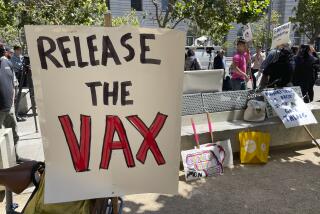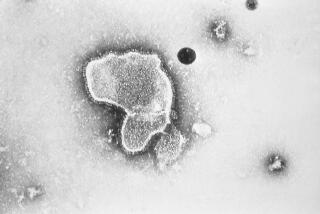Hope Seen for Vaccine to Tame Ebola Virus
- Share via
The Ebola virus--widely feared because of its horrifying symptoms and lethal nature--may be on the verge of being tamed.
Federal researchers report in today’s Nature that they have devised a vaccine that fully protects monkeys against the virus--the first proof that vaccination against Ebola is possible in primates and a major step toward development of a vaccine for humans.
Although outbreaks of the virus have so far killed only a few hundred people in Africa, its fatality rate--as many as 90% of those infected die of massive hemorrhaging--makes it exceptionally difficult to treat.
Researchers fear, moreover, that a slight mutation in the virus will allow it to spread throughout the world. Pig and bird influenza viruses, as well as the AIDS virus, are previous examples of pathogens that were once restricted to certain areas but have suddenly erupted into human plagues.
An effective Ebola vaccine would provide immediate protection for researchers studying the virus and public health personnel treating outbreaks. It would also make it possible to short-circuit potential outbreaks before they spread more widely.
“We’re quite excited about the results,” said epidemiologist James LeDuc of the Centers for Disease Control and Prevention, who was not involved in the study. The research “has clearly shown that you can protect an individual. . . . This is a significant step in our understanding about how to protect people from this disease.”
Vaccines developed in subhuman primates are usually applicable to humans because humans and monkeys have similar immune systems.
The vaccine’s development by a team led by Dr. Gary Nabel of the National Institute of Allergy and Infectious Diseases in Bethesda, Md., comes as the latest outbreak of Ebola in Uganda is winding down.
At least 145 people have died in the outbreak, which began in September in the rural town of Gulu, 225 miles north of Kampala. A 1995 outbreak in Zaire killed 245 people.
The Ebola virus was identified in 1976 after an outbreak in a village along the Ebola River in the Democratic Republic of Congo, then known as Zaire.
Since then, it has been portrayed as a scourge in countless science fiction books and movies. It achieved notoriety as the star attraction in the book “The Hot Zone” and the movie “Outbreak,” and has been featured in a variety of other books and movies.
The virus’ symptoms include severe pain, high fever and bleeding from organs throughout the body. It does not, however, liquefy internal organs, as is often claimed.
The virus is spread by bodily contact, which is why the victims of an outbreak typically include family members of the first victims and health care workers who treat them. There are no specific treatments and the mortality rate ranges from 50% to 90%, depending on which of the three known strains produces the infection.
“Ebola is a difficult virus because currently available antiviral drugs have no proven effect on it and we do not know its natural [host], making environmental control impossible,” said Dr. Anthony Fauci, director of the National Institute of Allergy and Infectious Diseases. Teams of researchers from the World Health Organization and other groups have been searching for an animal host in Africa, but have yet to find one.
“A vaccine is the best hope for protecting humans from infection,” he added.
Researchers have previously used killed Ebola virus and virus proteins in attempts to produce a vaccine, but without success.
One reason is because “this is an extremely dangerous bug to work with, and [consequently] we don’t have thousands of people trying to solve the problem,” LeDuc said. People have to work in high-level bio-containment laboratories wearing “moon suits” and other protective gear, he added.
Those researchers “will be a small but very grateful part of society” when a vaccine is available, he said.
Nabel’s team took a two-pronged approach called prime-boost that it had previously shown would protect guinea pigs from the Ebola virus.
The monkeys’ immune systems are first primed by injecting them with so-called naked DNA containing the genes for several Ebola viral proteins. This stimulates the animals’ white blood cells to attack the virus when they encounter it.
This initial immunity is boosted by infecting the animals with a harmless virus that also carries Ebola genes. This step stimulates the production of antibodies against the virus.
Nabel’s team reports today that four macaque monkeys that were given this vaccine survived with no trace of infection when they were deliberately infected with a low dose of the Ebola virus. Three other monkeys that were not vaccinated contracted the disease when they were given the same dose and died within a week.
“This is proof of the concept that you can generate immune protection against Ebola,” Nabel said. “We didn’t know that for sure.”
More research is needed in primates to understand how the protection is produced and to determine what will happen if the animals are exposed to larger doses of the virus, he said.
Although those experiments are proceeding, “it is feasible to begin preliminary studies of safety and immune response in humans,” he added. Such studies will begin after the first of the year.
More to Read
Sign up for Essential California
The most important California stories and recommendations in your inbox every morning.
You may occasionally receive promotional content from the Los Angeles Times.










